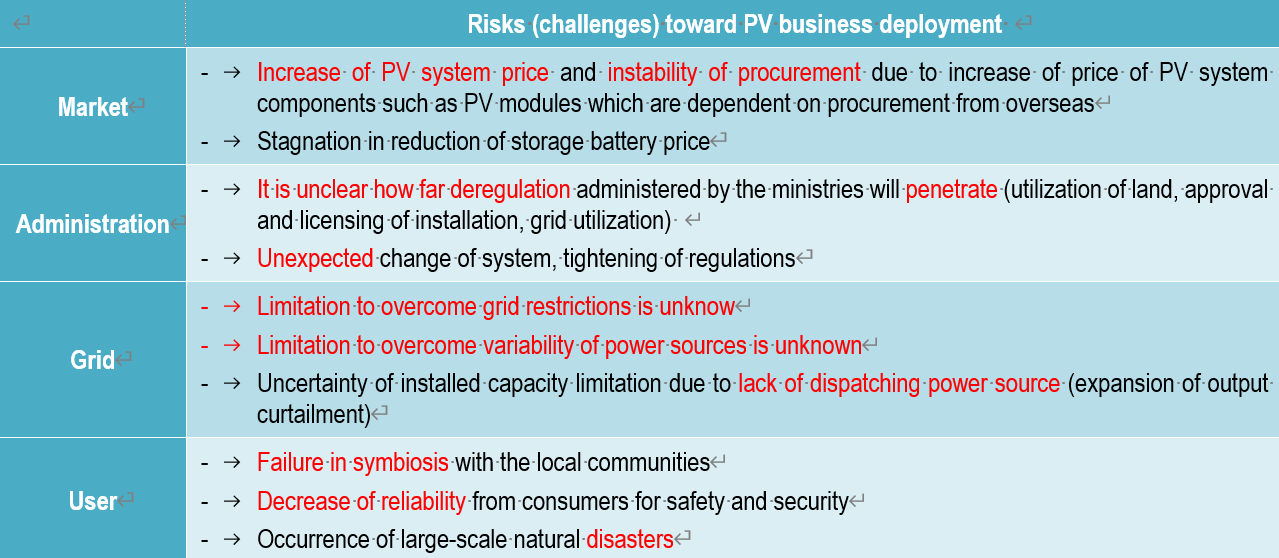The revised Law Concerning the Promotion of the Measures to Cope with Global Warming was enacted and will be enforced from April 2022. The basic principle was added and “realization of a decarbonized society by 2050” is clearly stated in the revision which was conducted for the first time in five years. Municipalities will establish “renewable energy promotion areas” and created the system aiming to expand renewable energy introduction, which will lead to regional revitalization. Furthermore, setting a renewable energy installation target has become mandatory for prefectures, ordinance-designated cities and core cities (obligation to make efforts for municipalities) under the action plan for global warming prevention.
The enforcement of the revised law will enable the Ministry of the Environment (MoE) to expand renewable energy introduction led by municipalities, and a new road will be open for renewable energy power producers to expand dissemination through the system of promotion areas.
Meanwhile, the Ministry of the Economy, Trade and Industry (METI) has come close to concluding the discussions on the formulation of the sixth Strategic Energy Plan, aiming for realization of 2050 Carbon Neutrality and 46 % reduction in greenhouse gas (GHG) emissions by 2030. The 2030 renewable energy installation target can be estimated as 270.7 billion to 290.3 billion kWh (25 % to 27 %) assuming that the renewable energy ratio in the energy mix for 2050 is 50 % to 60 %. However, further discussion is necessary since the current estimation does not include quantitative policy effects nor the policies whose feasibility is not clear. Among the five renewable energy sources, the Continuous efforts scenario and the Enhanced policies scenario for four power sources excluding PV have already been presented. As for PV, only the Continuous efforts scenario with the estimated installation of 87.6 GW has been presented, and further discussion shall be made for the Enhanced policies scenario on PV. Therefore, given that PV requires a shorter lead time for installation than renewable energy sources, it is likely that the installation target for PV in 2030 will be set to exceed 100 GW as to achieve 46 % GHG reduction by 2030, on the premise that related ministries will deepen cooperation and collaboration.
The Task Force for comprehensive review of regulations on renewable energy, etc. by the Cabinet Office aims to make renewable energy a mainstream power source as well as achieve maximum installation. The Task Force is urging METI, MoE, the Ministry of Agriculture, Forestry and Fisheries (MAFF), and Ministry of Land, Infrastructure, Transport and Tourism (MLIT) to quickly revise the regulations toward the expansion of PV dissemination, and the ministries are starting movements towards deregulation. Besides, from the industry, an increasing number of companies of large-volume power consumption are making efforts to procure power from renewable energy through introduction of PV systems at their in-house facilities, following the 2050 Carbon Neutrality Declaration by Prime Minister Yoshihide Suga. The finance sector is also moving towards avoiding climate change risks and promoting expansion of renewable energy introduction from the perspective of providing funds.
In this way, expansion of renewable energy installation target from the policy perspective, expansion of transition to renewable energy sources by the industry, induction of renewable energy utilization from the finance sector, etc. can be interpreted as a change of business environment that should be welcome for the PV industry towards future self-reliant development. From now on, in addition to full-scale enforcement of policies towards achieving 46 % GHG reduction by 2030, deregulation for installation deployment and expansion of installation location by municipalities will also start. Expansion of PV introduction will shift to a new stage where it stands as the key to green growth.
Up till today in Japan, the PV industry has been protected by the FIT program and achieved PV installation of 60 GW scale. Although PV has not reached the international price, it has achieved a cost reduction of 70 % from the cost at the start of the FIT program. Hereafter, PV is required to achieve dramatic development as the next generation energy industry aiming towards creation of a renewable energy-oriented economic society. Nonetheless, in terms of installation exceeding 100 GW, PV will be facing challenges that cannot be overcome by PV technology alone, including location and integration with power storage, and it will be necessary to prepare to overcome the risks (challenges) over PV business deployment, as shown in Table 1.
In the market, overseas dependence has been increasing for PV system components including PV modules, and there are risks of price increase and procurement instability.
Furthermore, expansion of installation will be limited unless price reduction of storage battery which is essential for the growth of PV progresses.
In the area of policies, deregulation administered by ministries is progressing on the utilization of land, approval and licensing of installation, grid utilization, etc. However, it is unclear how far it will penetrate. As for the power grids, risks of limitation of acceptance related to the grid, such as overcoming grid restrictions and variable power sources, suppression of installed capacity due to lack of dispatching power sources, etc. are expected. Form the user side, risks of disaffection such as a failure in symbiosis with the local communities, decrease of reliability for safety and security due to accidents, occurrence of large-scale natural disasters, etc. can be listed. The risks as mentioned above which determines the future development of PV cannot be solved by the PV industry alone, but we shall not fail to deepen cooperation with related industries including the government, and take measures to reduce the risks for PV business deployment. PV is an already established technology which will take initiative in achieving 2050 Carbon Neutrality. We shall start now to make efforts to establish a system to achieve installation exceeding 100 GW from the supply side, demand side, government side, technology side, finance side with integrated efforts of the industry, academia, government and finance.
Table 1 Future risks (challenges) toward PV business deployment
 ©RTS Corporation
©RTS Corporation
